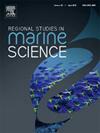Modeling coastal vulnerability in the Indian Sundarban under possible Shared Socioeconomic Pathways (SSPs)
IF 2.1
4区 环境科学与生态学
Q3 ECOLOGY
引用次数: 0
Abstract
Considering the dynamic and complex nature of the Indian Sundarbans, coupled with projected sea level rise (SLR), we employed an adapted methodology to identify vulnerable zones along the coastal belts of this delta. The analysis was conducted using InVEST, an open-source model developed by Stanford University. SLR is considered the primary factor in assessing flood-prone areas along the inhabited islands, particularly under cyclone-induced storm surges. A Coastal Exposure Index (CEI) was calculated for two Shared Socioeconomic Pathway (SSP) scenarios, SSP2–4.5 and SSP3–7.0 to account for the projected impact of SLR in the future. Along with SLR, key model inputs included bathymetry, continental shelf characteristics, shoreline geomorphology, wind and wave factors, and the spatial distribution of mangrove habitats. The accuracy assessment yielded a mean absolute error (MAE) of 0.0970 when compared with field measurements, demonstrating strong model reliability. The projected shift in CEI values is concerning; areas classified as low- and moderate-exposure are expected to transition to higher exposure categories by 2050 and 2100 under both SSP scenarios. By 2050, an increasing number of village blocks are projected to experience submergence during extreme precipitation events and storm surges. By 2100, the situation is likely to worsen, with an even greater number of village blocks at risk of submergence, particularly under SSP3–7.0, emphasizing the urgent need for mitigation and adaptation strategies.
基于可能的共享社会经济路径(ssp)的印度孙德尔邦沿海脆弱性建模
考虑到印度孙德尔本斯的动态和复杂性,再加上预计的海平面上升(SLR),我们采用了一种适应的方法来确定该三角洲沿海地带的脆弱地带。该分析是使用斯坦福大学开发的开源模型InVEST进行的。SLR被认为是评估有人居住岛屿沿线易受洪水影响地区的主要因素,特别是在气旋引发的风暴潮下。计算了两种共享社会经济路径(SSP)情景(SSP2-4.5和SSP3-7.0)的沿海暴露指数(CEI),以说明SLR在未来的预测影响。除了SLR之外,关键的模型输入还包括水深、大陆架特征、海岸线地貌、风浪因子和红树林栖息地的空间分布。与现场测量结果相比,精度评估的平均绝对误差(MAE)为0.0970,表明模型具有较强的可靠性。预计CEI值的变化令人担忧;在两种情景下,被列为低和中等暴露的地区预计将在2050年和2100年过渡到较高暴露类别。到2050年,预计将有越来越多的村庄在极端降水事件和风暴潮期间被淹没。到2100年,情况可能会恶化,更多的村庄街区面临被淹没的风险,特别是在SSP3-7.0级的情况下,这强调了迫切需要制定缓解和适应战略。
本文章由计算机程序翻译,如有差异,请以英文原文为准。
求助全文
约1分钟内获得全文
求助全文
来源期刊

Regional Studies in Marine Science
Agricultural and Biological Sciences-Ecology, Evolution, Behavior and Systematics
CiteScore
3.90
自引率
4.80%
发文量
336
审稿时长
69 days
期刊介绍:
REGIONAL STUDIES IN MARINE SCIENCE will publish scientifically sound papers on regional aspects of maritime and marine resources in estuaries, coastal zones, continental shelf, the seas and oceans.
 求助内容:
求助内容: 应助结果提醒方式:
应助结果提醒方式:


